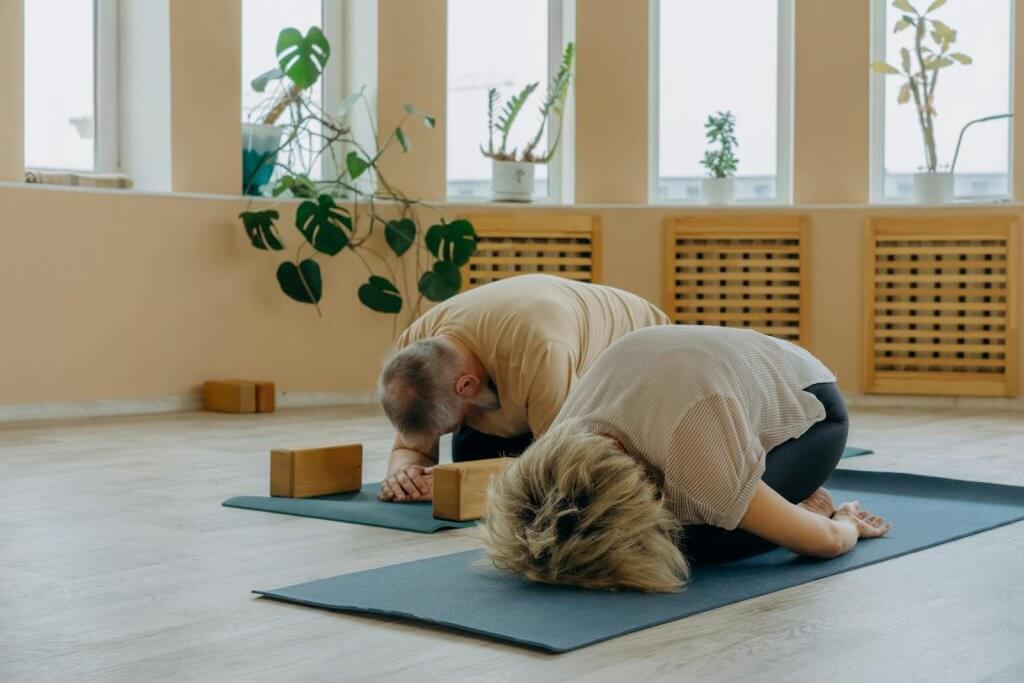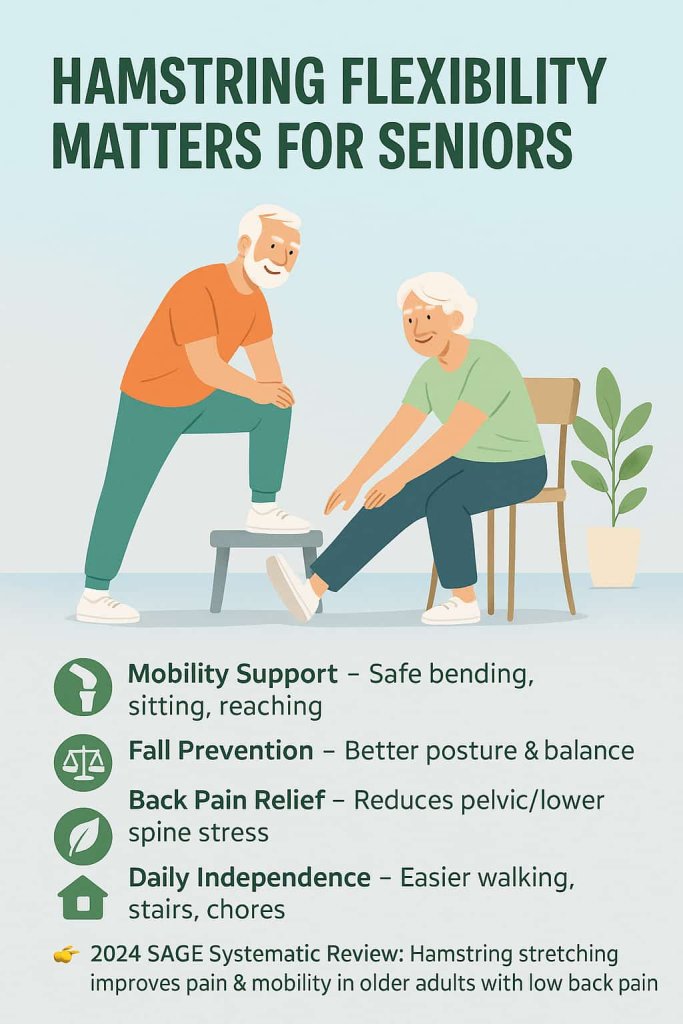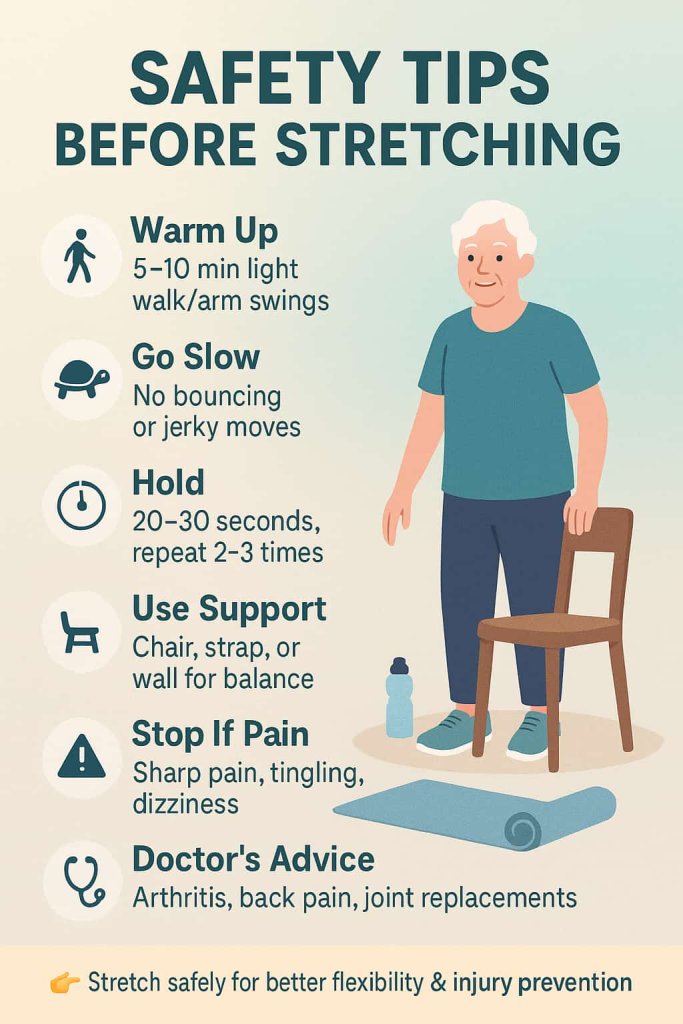Yes — seniors can safely improve flexibility with hamstring stretches, and these exercises are among the best ways to reduce stiffness and protect mobility. Tight hamstrings often cause back discomfort, limit daily movement, and increase fall risk. Stretching regularly helps older adults walk, climb stairs, and bend more comfortably.

This guide explains the 12 best hamstring stretches for seniors, with step-by-step instructions, safety tips, and modifications. Each stretch is gentle, can be done at home with minimal equipment, and supports independence.
👉 According to the Mayo Clinic, stretching improves flexibility, boosts blood circulation, and reduces injury risk in older adults (Mayo Clinic).
Why Hamstring Flexibility Matters for Seniors

- Mobility support – Hamstrings allow safe bending, sitting, and reaching.
- Fall prevention – Flexible muscles improve posture and stability.
- Back pain relief – Tight hamstrings increase pelvic tilt and stress on the spine.
- Daily independence – Easier walking, stair climbing, and household chores.
👉 A 2024 Systematic Review (SAGE Journals) found hamstring stretching significantly improved pain and mobility in adults with low back pain.
Safety Tips Before Stretching

- Warm up with 5–10 minutes of light walking or arm swings.
- Stretch slowly — no bouncing or jerky movements.
- Hold each stretch 20–30 seconds; repeat 2–3 times.
- Use a chair, strap, or wall for balance support.
- Stop if you feel sharp pain, tingling, or dizziness.
- Consult your doctor if you have arthritis, severe back pain, or hip/knee replacements.
12 Best Hamstring Stretches for Seniors
Tight hamstrings are one of the most common causes of stiffness, back pain, and mobility issues in older adults. Whether you’re active or just looking to stay flexible for daily tasks, these gentle stretches can be adapted for all levels.
Below are 12 safe and effective hamstring stretches for seniors, with clear instructions, benefits, and trainer tips.
1. Seated Hamstring Stretch (Chair)
How to do it:
- Sit tall on a sturdy chair.
- Extend one leg straight, heel on the floor, toes pointing up.
- Lean forward slightly from the hips (not the back).
- Hold 15–30 seconds. Switch sides.
Benefits: Relieves hamstring tightness, supports walking mobility, and helps with sitting-to-standing movements.
Trainer Tip: Keep your chest lifted and back straight—avoid rounding shoulders.
2. Standing Hamstring Stretch (Wall Support)
How to do it:
- Stand facing a chair, step, or wall.
- Place one heel on the surface, leg straight, toes up.
- Lean forward gently until you feel a stretch.
- Hold 15–20 seconds per side.
Benefits: Improves flexibility for walking, stair climbing, and balance.
Trainer Tip: Use wall or chair support if needed to maintain stability.
3. Supine Hamstring Stretch (With Strap or Towel)
How to do it:
- Lie flat on your back.
- Loop a strap, belt, or towel around one foot.
- Slowly lift your leg toward the ceiling.
- Keep the opposite leg bent or straight on the floor.
Benefits: Provides a deep stretch without balance demands—ideal for seniors with limited mobility.
Trainer Tip: Keep your lower back flat against the floor.
4. Seated Forward Fold
How to do it:
- Sit on the floor with legs extended straight.
- Lean forward gently, reaching toward shins, ankles, or toes.
- Hold 10–20 seconds, breathe deeply.
Benefits: Stretches hamstrings and lower back, improves posture.
Trainer Tip: Bend knees slightly if flexibility is limited.
5. Chair-Assisted Forward Bend
How to do it:
- Stand behind a chair.
- Place hands on the backrest.
- Step back, hinge forward at the hips, keeping legs straight.
- Stop when hamstrings stretch.
Benefits: Safely stretches hamstrings while protecting the lower back.
Trainer Tip: Keep spine neutral—avoid rounding.
6. Reclined Hamstring Stretch with Bent Knee
How to do it:
- Lie on your back.
- Hold behind one thigh with both hands.
- Slowly straighten leg upward until stretched.
- Hold 15–30 seconds.
Benefits: Gentle option for seniors with tight hamstrings or limited range.
Trainer Tip: Do not lock the knee—keep it slightly soft.
7. Wall Hamstring Stretch
How to do it:
- Lie near a wall.
- Place one leg up against the wall, other leg flat on the floor.
- Relax and hold 20–40 seconds.
Benefits: Provides a passive, safe stretch with no strain.
Trainer Tip: Adjust distance from wall to control intensity.
8. Seated Towel Stretch
How to do it:
- Sit tall with legs extended straight.
- Loop towel or strap around your feet.
- Gently pull toward you while keeping back straight.
Benefits: Perfect for seniors with limited reach or flexibility.
Trainer Tip: Focus on pulling gently, not forcefully.
9. Standing Hamstring Curl Stretch
How to do it:
- Stand holding a chair or wall for support.
- Bend one knee, bringing heel toward buttocks.
- Hold ankle gently for 15–20 seconds.
Benefits: Stretches hamstrings while also improving balance.
Trainer Tip: Keep knees close together—don’t let one flare out.
10. Modified Downward Dog (Wall or Chair Support)
How to do it:
- Place hands on a wall or chair.
- Step feet back, bend at hips, and stretch spine long.
- Keep legs straight but soft at the knees.
Benefits: Lengthens hamstrings, calves, and spine in a safe way.
Trainer Tip: Avoid dropping your head—keep neck aligned.
11. Figure-4 Stretch (Chair or Floor)
How to do it:
- Sit tall on a chair.
- Cross one ankle over opposite knee.
- Lean forward slightly until you feel a stretch.
Benefits: Stretches hamstrings, hips, and glutes together.
Trainer Tip: Keep back tall—avoid pressing knee down forcefully.
12. Dynamic Hamstring March (Warm-Up Stretch)
How to do it:
- Stand tall, hold chair if needed.
- Slowly lift one straight leg forward (like a light kick).
- Alternate sides in a marching motion.
Benefits: Warms up hamstrings and hips before static stretches or walking.
Trainer Tip: Small range of motion is fine—focus on control, not height.
How Often Should Seniors Stretch?
Experts recommend stretching at least 2–3 times per week, though daily stretching is ideal. Even 10–15 minutes a day can improve flexibility, reduce stiffness, and make everyday movement easier.
👉 A study in Physiotherapy Theory and Practice (2021) found that stretching three times weekly for 8 weeks significantly improved flexibility and functional mobility in older adults.
Who Should Avoid Hamstring Stretches?
- Seniors with recent hip or knee surgery (unless cleared by a doctor).
- Individuals with acute sciatica, severe arthritis, or balance problems.
- Anyone experiencing sharp nerve pain or tingling during stretches.
Always check with a healthcare provider before beginning new exercises.
FAQ: Hamstring Stretches for Seniors
1. How long should seniors hold a hamstring stretch?
20–30 seconds per stretch is safe; repeat 2–3 times.
2. Can seniors stretch hamstrings daily?
Yes, daily stretching is safe and often recommended.
3. What’s the best time to stretch hamstrings?
After light warm-up or at the end of exercise.
4. Can stretching hamstrings reduce back pain?
Yes — flexible hamstrings relieve pressure on the lower back and pelvis.
5. Do seniors need equipment for hamstring stretches?
No, but a strap, towel, or chair makes stretches easier and safer.
6. Are dynamic stretches safe for seniors?
Yes, when done gently as a warm-up before static holds.
7. Should seniors avoid hamstring stretches if they have arthritis?
Not necessarily — gentle, modified stretches are usually safe, but consult your doctor first.
Conclusion
Hamstring flexibility is essential for seniors who want to stay active, pain-free, and independent. With simple stretches — many of which can be done at home using a chair or towel — older adults can protect mobility, reduce back strain, and move with more confidence.
👉 Start today with 2–3 stretches, hold for 20–30 seconds, and build up gradually. Small daily habits lead to lasting results.
